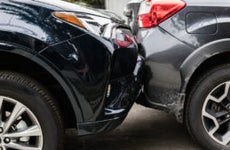What is no fault coverage?

The Bankrate promise
At Bankrate, we strive to help you make smarter financial decisions. To help readers understand how insurance affects their finances, we have licensed insurance professionals on staff who have spent a combined 47 years in the auto, home and life insurance industries. While we adhere to strict , this post may contain references to products from our partners. Here's an explanation of . Our content is backed by Coverage.com, LLC, a licensed entity (NPN: 19966249). For more information, please see our .
Depending on your state’s car insurance laws, you may live in a fault or no-fault state, with the main difference between the two being how you get reimbursed for injuries after a covered accident. In no-fault states, personal injury protection (PIP) pays out regardless of who is at fault, and may financially help injured parties get immediate medical care after an accident by avoiding small-claims lawsuits and delayed settlement.
As a driver, it may be important to know if your state follows fault or no-fault laws. Not only does it determine how you file claims, but it may also affect the type of car insurance you need, as well as the cost of your insurance premium.
- In a no-fault state, your insurance company initially pays for your medical bills and lost wages after a covered accident, up to your coverage limit, regardless of which driver caused the crash.
- Drivers in no-fault states are required to carry personal injury protection (PIP) coverage in addition to basic liability coverage.
- PIP insurance does not cover damages to your vehicle, another driver’s medical expense or medical bills above your policy’s limit.
What is no-fault coverage?
A common question many drivers have is, “What is no-fault insurance?” No-fault coverage, also known as PIP, was designed to lower the cost of auto insurance by keeping smaller-dollar claims out of the courts. PIP provides coverage for injuries you sustain in a car accident regardless of fault, up to the limit of PIP coverage you carry, and pays out right away, reducing the likelihood of one party bringing a lawsuit against the other. Although there are certain circumstances where you may still sue in a no-fault state (accidents with high-cost serious injuries, for instance), these situations are fairly limited. PIP may also pay for medical-related expenses, such as lost income, housekeeping services and funeral expenses (this typically also applies to your passengers, depending on the state).
PIP insurance is mandatory in no-fault states, but each state sets its own guidelines regarding coverage limits. For instance, no-fault insurance in Michigan is especially robust — you can choose to have an unlimited PIP limit, meaning there is no cap on how much PIP may pay out in a covered accident.
In some states, you may be able to pick and choose what options you’d like available on your PIP coverage. For example, you can waive the work loss portion of your PIP coverage in Florida. While this may result in a lower premium, it also means that your PIP insurance will not pay for lost wages resulting from injuries sustained in a car accident.
New Jersey is also known for its many PIP options. In the Garden State, you can choose to cover medical expenses only, medical and additional costs, or even opt to lower the amount of PIP coverage you have based on the type of outside medical insurance you carry.
Since PIP options may be complicated and vary state by state, you may want to contact a licensed agent in your area if you have specific questions.
How does no-fault coverage work?
Imagine you are in an accident that results in a broken leg, and you live in a no-fault state. Regardless of who caused the accident, when you go to the emergency room to have the leg examined, you will give the hospital your auto policy information. The hospital will bill your insurance company for the costs of the medical treatment, or, if you pay the costs at that time, your insurer should send you a check for the amount you paid (up to the limit of personal injury protection you carry).
If you are involved in a car accident and carry no-fault insurance, you will typically be covered for at least some of your own medical expenses and lost pay. Some no-fault states limit the amount of money you can collect from your auto insurer, while others do not, depending on the PIP option you choose.
Can a driver still be at fault in a no-fault state?
It’s important to note that if you have an accident in a no-fault state, that does not mean that the car insurance companies involved will not determine who was at fault in the accident. Instead, it means that no-fault coverage (PIP) is required and that it will pay first if you are injured in a car accident.
To illustrate this, let’s say you were the driver in a not-at-fault accident and sustained significant injuries. First, your PIP coverage will trigger to pay for your injuries and applicable medical expenses. If your PIP limits are exceeded, the at-fault driver’s bodily injury liability coverage may then take care of your outstanding balance (up to the limit of bodily injury liability coverage they have on their policy).
The opposite also applies here. Suppose you were the at-fault party in an accident and caused injuries to the other driver. In that case, their injuries will be covered by their PIP insurance first, with your bodily injury liability coverage covering the remaining medical expenses (up to the limit of bodily injury coverage you carry).
Determining negligence
Your state’s laws dictate how negligence (or fault) is determined. Determining negligence is an essential step in the claims process — even in a no-fault accident — so that your insurance company knows what coverage types should apply.
For instance, liability coverage always pays for the other party’s medical expenses and property damage (up to the limits you carry) if you were the at-fault driver. To know if your liability coverage will kick in, your insurance company needs to determine if you were the one who caused the accident. Although witnesses are good to have, anecdotal evidence alone is usually not enough to establish negligence. Instead, insurance companies usually rely on official police reports when available.
Below are the different types of fault determinations a state may use.
Pure contributory negligence
Drivers in states that use pure contributory negligence are only eligible for a settlement if the insurance company determines they were 100 percent non-negligent (or not at fault) for the accident. In other words, you may not recover damages if the company determines that you played even the smallest part in the accident.
Pure comparative negligence
If you live in a state that uses pure comparative negligence, your insurance payout is based on the percentage of fault you carry. For instance, if the company finds you 70 percent at fault and the other driver 30 percent at fault, you would have to cover 70 percent of the damages, and the other driver would cover the remaining 30 percent. If your liability limits aren’t high enough to cover your percentage of the damage, you will likely have to pay the difference out of pocket.
Modified comparative negligence
Modified comparative negligence sets a threshold for fault, usually around 50 percent. You are eligible for a payout if your negligence was less than the threshold.
States with no-fault coverage
The list of states below are no-fault states and require drivers to carry PIP coverage:
- Delaware
- Florida
- Hawaii
- Kansas
- Kentucky
- Massachusetts
- Michigan
- Minnesota
- New Jersey
- New York
- North Dakota
- Oregon
- Pennsylvania
- Utah
In several additional states, PIP is available but is not required. They are:
- Arkansas
- Maryland
- Texas
- Washington
- Washington, D.C.
If you have questions regarding no-fault availability in your state, you might find it helpful to speak with an insurance professional.
What does no-fault insurance cover?
The regulations on what PIP covers may vary from state to state, but in general, these are expenses that will typically be paid by your PIP coverage in a no-fault state:
- Your medical expenses: These may include hospital fees, rehabilitation, dental costs, ambulance services, prescriptions, surgery and prosthetic devices.
- Lost wages: If you lose your job or are unable to work due to your injuries, lost wages may be part of the settlement.
- Funeral expenses: If your accident results in death, insurance may help pay for the costs.
- Essential services: In some cases, for example, if injuries are incurred by a homeowner, PIP may cover the cost of hiring out household tasks.
What won’t no-fault insurance cover?
Here are a few of the expenses that PIP likely won’t cover in a no-fault state:
- Injuries to the other driver or their passengers: In most cases, the other driver’s PIP insurance should cover these, at least initially. If your policy does cover these costs, it would be from your bodily injury liability coverage.
- Injuries to pedestrians: If you are a pedestrian and are hit by a car, your PIP will likely cover you. If you are in the car and hit a person who is walking or riding a bike, their insurance should cover them in most cases.
- Medical costs over the limit of your coverage: You cannot get more coverage than your policy limits. However, in some states, you may be able to sue the other driver for costs over your coverage if the accident is their fault.
- Damage to your car or any other object: This includes items such as a fence or lamp post. If you have collision insurance, it may cover damage caused to your vehicle by a covered accident. Your property damage liability is what would cover damage that you cause to other vehicles or objects.
- Damage caused to your car by bad weather, vandalism, theft or hitting an animal: You may be covered for these losses if you have optional comprehensive insurance.
Check your insurance policy for more details about inclusions and exceptions.
Frequently asked questions
-
-
Whether or not no-fault insurance is mandatory depends on your state. You are required to have no-fault insurance — or PIP coverage — in 14 states. These states are Delaware, Florida, Hawaii, Kansas, Kentucky, Massachusetts, Michigan, Minnesota, New Jersey, New York, North Dakota, Oregon, Pennsylvania and Utah.If you live in Arkansas, Maryland, Texas, Washington or Washington, D.C., no-fault coverage is available, but you can choose to reject it.
-
Yes. Many people use the terms no-fault insurance and PIP insurance interchangeably, and they mean the same thing. However, when reviewing your policy documents, you may see this coverage denoted as personal injury protection or PIP rather than no-fault insurance.
-
The cost of PIP insurance depends on a few factors, including (but not limited to) the state you live in, your age, gender, the type and age of your car and how much coverage you would like to purchase. The cost of the PIP portion of your insurance can be found on your insurance documents.
-
How car damage is handled after a car accident depends on the circumstances. Collision coverage will help pay to repair damages to your vehicle if you are at fault in an accident, hit a stationary object, are the victim of a hit-and-run accident or are hit by someone without insurance (in some states). Comprehensive, on the other hand, is designed to cover your vehicle for things outside of your control, such as acts of nature, theft, vandalism, fire, hitting an animal and falling objects. Additionally, your property damage liability coverage will help pay for the damage you cause to another vehicle (or another person’s property) in an at-fault accident.Furthermore, how, or if, your insurance company will pay for car damage may depend on your state’s negligence laws.
-
Related Articles



